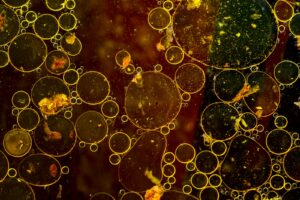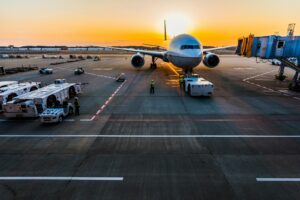Wood fuel plan to cut plane CO2 branded as ‘pipe dream’
Plans to cut airline CO2 using greener jet fuels made from waste wood have been dismissed as a ‘pipe dream’ by environmentalists.
Several high octane, waste-based biofuels are being tested by airlines as a way of curbing CO2. UN officials are set to endorse these fuels as a key part of global plans to stabilise aviation emissions by 2020. But critics say the plans are unrealistic and airlines are not taking the issue seriously.
One of the big failures of the Paris climate agreement, adopted in December 2015, is that it doesn’t cover emissions from shipping or aviation.
The scale and impact of carbon from the booming airline business is heavily contested. The industry points out that in 2015 only 2% of human emissions of CO2 came from aircraft.
Environmentalists point out that this doesn’t include the warming impact of contrails or other gases and aerosols. They believe the true impact is about 5%.
Earlier this year, the International Civil Aviation Authority (ICAO), the UN body that regulates this sector, produced a report that predicted a three-fold increase in emissions from airplanes by 2050 if nothing is done to restrict carbon.
ICAO has developed a long-term plan that it says will ensure that, by the middle of the century, aviation emissions will be half of what they were in 2005.
One of the key parts of that plan is green jet fuel.
Since Virgin Atlantic flew the first flight powered partly by biofuel in 2008, there have been dozens of tests with many different types of alternative jet fuels, often made from oil seed crops or animal fats.
But in the US earlier this year, the Federal Aviation Authority gave the go-ahead to a new fuel making process that some people believe will be a game changer for greener flying.
The new biofuel is made from a type of alcohol called isobutanol, which occurs naturally in the fermentation process and can be found in many items including bread and scotch whiskey.
Pine scented soup
At a large, warm and sweet smelling industrial facility in St Joseph’s, Missouri, fermenting tanks three stories tall contain a swirling mixture of wood pulp, water and enzymes.
The engineers here call the liquid, a ‘broth’, and it’s from pine-scented soup that isobutanol is extracted.
‘It’s like making a hot toddy, it has a bit of an alcoholic smell to it but you can still smell the undertones of the pine feedstock in the fermentation,’ said Andrew Hawkins from Gevo, the company that has been licensed to make jet fuel using this new method.
The enzymes are used to extract the sugars from the pine. Genetically modified yeast then deliver the isobutanol from the sugars. By this stage, the smell of pine has long departed and the clear liquid remaining has the breathtaking whiff of a high-octane fuel.
One more refining step, at another facility, is required to complete the process.
What’s making airlines excited about using isobutanol based fuel is the fact that it is much more powerful than ethanol, the current biofuel of choice for transport.
Another attraction is that unlike, ethanol, jet fuel made from isobutanol can be carried and mixed in the same pipes and fuel trucks as petroleum products.
By using forest residue, supporters believe the new fuel can make a real and sustainable difference to airline carbon emissions as trees soak up CO2 as they grow and it is only the waste from their harvesting that’s used in production.
‘We are short cutting mother nature and sucking carbon directly out of the atmosphere, that maybe yesterday’s plane put into the atmosphere,’ Andrew Hawkins told BBC News.
‘We then create sugars via these trees and then turn that back into fuel.’
A question of cost?
Gevo say they are planning to increase production to around 1 million gallons this year.
The company believe they can reduce the cost of production to around $3 a gallon – but that is still around $1.80 more than the current market price of petroleum based jet fuel.
Isobutanol made from corn is now being been used in test flights by Alaska Airlines in blends of up to 30% with regular fuel.
But whether they are made from wood waste or corn, the financial cost of these new fuels are likely to prove a major problem according to environmentalists.
‘They are far too expensive, and they are not delivering the emissions reductions that would justify the investment,’ said Bill Hemmings of campaign group Transport & Environment.
‘The new fuels are two or three times the cost of existing jet fuels, no-one in their right mind would pay that price. People continue to bang that drum about new biofuels, but they are not going to deliver. It’s all fairytale stuff.’
Attempts to regulate airline emissions have proved very difficult as countries haven’t been able to agree on the ways of measurement and responsibility. For example, if an airplane owned by a Middle Eastern airline flies from a poor African country to a poor Asian destination, who should ‘own’ these emissions?
ICAO believe they have found a way forward that would allow airlines to offset emissions in the future by purchasing credits from certified reduction schemes, such as tree planting.
But their long-term goal of halving the level of 2005 emissions by 2050 depends on a rapid uptake of green fuels.
Critics say that this is impossible – it would require around 170 large scale bio-refineries to be built every year between 2020 and 2050, at a cost of up to $60bn a year.
Flying gorillas?
As well as biofuels, UN officials meeting in Montreal in September will also announce tougher standards for new aircraft designs to curb CO2 that will come into force in 2028. Green campaigners say this approach is ‘incredibly weak’.
They say that around 15% of aircraft flying today perform better than these future criteria.
Real change, they argue, won’t come through these vague international efforts. They believe that the key to solving the problem lies in the US.
‘The US is the 800 pound gorilla of carbon pollution in the sky,’ said Vera Pardee a lawyer with the Centre for Biological Diversity.
‘More than 30% of all international carbon pollution comes from the United States.
‘It is the duty of the US to get us out of this problem. If the US Environmental Protection Agency were to adopt meaningful standards then the international community will follow.
‘The airplane manufacturers are not stupid, they need to meet the demands of their markets, when a regulation goes into effect for one of their major markets, that will be the catalyst to cause emissions to finally be handled correctly and come down.’















